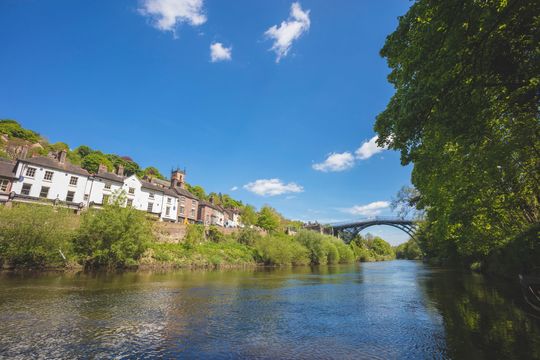
Ironbridge Gorge, at Telford.Getty
Some of the greatest historic sites in Britain illustrate how the world changed during the Industrial Revolution.
From the late 1700s, Britain’s population began its great migration. As the impact of the Industrial Revolution and its new technologies created mills and mines, changed transport and birthed manufacturing, working people left their rural, agrarian life for town and cash jobs. Here are some of the greatest visits illustrating how the world changed.
IRONBRIDGE GORGE, TELFORD
From Blists Hill Victorian Town to the Coalbrookdale Museum of Iron, there are 10 museums along this pretty River Severn valley justly recognized as the “Birthplace of the Industrial Revolution.” There’s also the world’s first iron bridge, of course.
www.ironbridge.org.uk
NATIONAL RAILWAY MUSEUM, YORK
The largest railway museum in the world is a highlight of any visit to York. From iconic locomotives like the Flying Scotsman and the carriages of Queen Victoria to an active engineering department and more than a million artifacts, this is a superb visit even for folks who didn’t know they were interested.
www.nrm.org.uk
RHONDDA HERITAGE PARK, PONTYPRIDD
For 200 years “black gold” meant coal, and the finest steam coal came from the valleys of South Wales. Here at the Lewis Merthyr Colliery, the story of the Rhondda Valley and the lives of its miners and their families unfolds. Take a trip down the pit.
www.rhonddaheritagepark.com
THE POTTERIES, STAFFORDSHIRE
The unique city of villages, Stoke-on-Trent, takes pride in being known as The Potteries. More formally, Stoke claims the title World Capital of Ceramics. Wedgwood, Aynsley, Portmerion and Royal Doulton are just a few of its 30 pottery attractions. For the historic story, though, visit the Gladstone Pottery Museum in Longton.
www.visitstoke.co.uk
QUARRY BANK MILL, GREATER MANCHESTER
Just south of Manchester is the village of Styal, virtually rebuilt when Samuel Greg built Quarry Bank Mill in the late 1700s. Today, the complex of cotton mill, Apprentice House, gardens and workers’ village is perhaps the most complete picture surviving of mill life almost 200 years ago.
www.nationaltrust.org.uk
BEAMISH, DURHAM
The award-winning Living Museum of the North, popularly known simply as Beamish, re-creates and reconstructs life in England’s Northeast from Georgian times through the early 20th century, from farm to mining village to Edwardian town complete with carousel.
www.beamish.org.uk
SALTAIRE, BRADFORD
In 1853, Sir Titus Salt moved his woolen mills out of Bradford to the banks of the River Aire, where he built a village for his workers that included a school, hospital, bathhouses, concert hall and even a billiard room. A masterpiece of enlightened entrepreneurship, Saltaire is justly a World Heritage Site.
www.saltairevillage.info
BRISTOL
Yes, Bristol is a fascinating, modern city. It is also a monument to England’s industrial technology—especially the role played by I.K. Brunel. During your visit, don’t miss the SS Great Britain, the Clifton Suspension Bridge and the functional beauty of Bristol Temple Meads station.
www.visitbristol.co.uk
NEW LANARK, LANARKSHIRE
Another social pioneer, Robert Owen, built a cotton mill village-like unto Saltaire. Beautifully restored, New Lanark, though, lies in the majestic south Lanarkshire valley of the River Clyde. You can even stay in the New Lanark Hotel and experience village life.
www.newlanark.org
BLAENAVON, SOUTH WALES
This was the village setting of How Green Was My Valley. More graphically today, Blaenavon is a World Heritage Site, anchored by the Big Pit: National Mining Museum and the Blaenavon Ironworks, featuring the best-preserved blast furnace of the Georgian era as well as refurbished workers’ cottages and company store.
www.world-heritage-blaenavon.org.uk
Read more
* Originally published in July 2016.





Comments